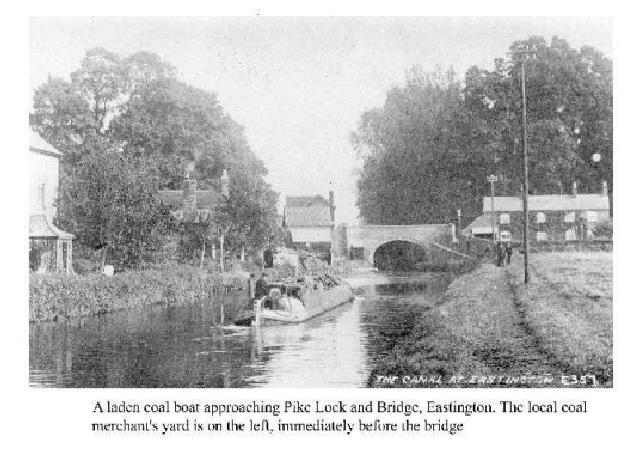
The effects of Coal and the Canal on Eastington
For several centuries, the social and industrial life of Eastington (as throughout the region) was inextricably bound up with, and dominated by, the manufacture of woollen cloth.
Initially the woollen mills relied on the water power of the River Frome,
but during the 19th century, steam power became increasingly important.
Water power was limited, and prone to seasonal fluctuations, but despite growing competition in the industry, there was a relatively slow take-
In pre-
An early attempt to provide a water-
Proponants of the Stroudwater canal recognised the importance of the price and regular supply of coal. When the Stroudwater Canal Company company was formed, many of the directors were closely linked to the mill trade, and knew that the two industries would support each other’s growth.
The Stroudwater Canal was opened in 1779 and cut through Eastington Parish, finally bringing a reliable means of moving large quantities of heavy, bulky cargo into and out of the village. Even so it was not until 1819 that steam power was introduced into Eastington’s mills.
The local mills were able to take full advantage of the new canal and the much cheaper coal that it provided . Coal for Henry Hicks' Eastington mill was unloaded at the coal wharf situated below Pike Bridge. As a valuable commodity, it was then stored in a coal pen near Meadow Mills where it was protected by high stone walls and locked doors, prior to transport to Meadow, Churchend and Millend Mills as required.

At its peak in the 19th century, Eastington itself became a thriving mini mill town, with virtually all of its social and industrial life connected to the cloth trade. Much of Eastington’s development during the first half of the century occurred as a result of the influence of the Hicks family who, for more than a generation, owned the mills and dominated virtually every aspect of village life.
Another important use for the canal was the transport of building materials. Both Millend and Churchend Mills were undergoing huge renovations from 1818 onward. The stone for Millend Mill’s new 5-
When Hicks added Meadow Mills to his little empire, the stone and timber coming via the canal were moved to the site by means of a tramway built expressly for the purpose.
Further upstream, between 1812-
Other building materials took the form of bricks. Some of the local soils were suitable for brick making and to some extent, this activity was encouraged by the opening of the canal. For instance, in 1840, a piece of land near Bond's Mill and another at Haywardsend (now part of Wycliff school) were producing bricks from kilns on the respective sites.
Upstream, coal for Bonds Mill was unloaded directly from boats into the mill's bunkers.

Local employment and social effects
When the canal came, its impact must have created gossip and excitement comparable to the coming of the M5 in the 1970s. Like the M5, it was a direct link to the outside world, and a carrier of news and information as well as cargo.
The canal assured the relative prosperity of the Eastington area, and consequent employment in mills, and also put an end to the employment problems that had been caused by water-
Some local labouring opportunities afforded by the construction and although skilled artisans would mostly have been brought in by the Company, there was a ‘dry dock’ for ship repair with a forge and carpenters shop just below Pike Bridge.
Lock keepers and ‘lengthmen’ would also have been employed locally.
Road stone was unloaded from the canal at the stone wharf, 50 yards above Pike Lock and road mending certainly employed a number of labourers from within the village.
The import of coal into the village proved important not only for the mill owner, but also for the villagers who came to rely on this for domestic fuel.
Immediately below Pike Bridge, the village coal wharf was established and the Wharf House was built in 1779. From here, coal was distributed to the village and surrounding area. During the 1800s, most of Eastington’s coal was bought by the village ‘coal club’ at preferential rates.
The Wharf House also later managed to achieve a degree of notoriety, as for part of its life, it apparently doubled as a cider house, much frequented by passing boatmen.
The canalside New Inn a short way upstream at New Town probably initially functioned in a similar manner.
Although few local men appear to have been employed on the canal boats themselves, a number of boatmen certainly ended their days within the village -
So we see that for several generations, the Stroudwater Canal provided Eastington with an important lifeline to the outside world. Its presence had a significant impact on the commercial and social life of the parish, forming the first reliable transport link that allowed the effective import of materials for local industry and to a lesser extent, a mechanism for moving its products to their end-
A precis of an article by Steve Mills -
The full article may be viewed/downloaded at this link:
Coal and the Canal
